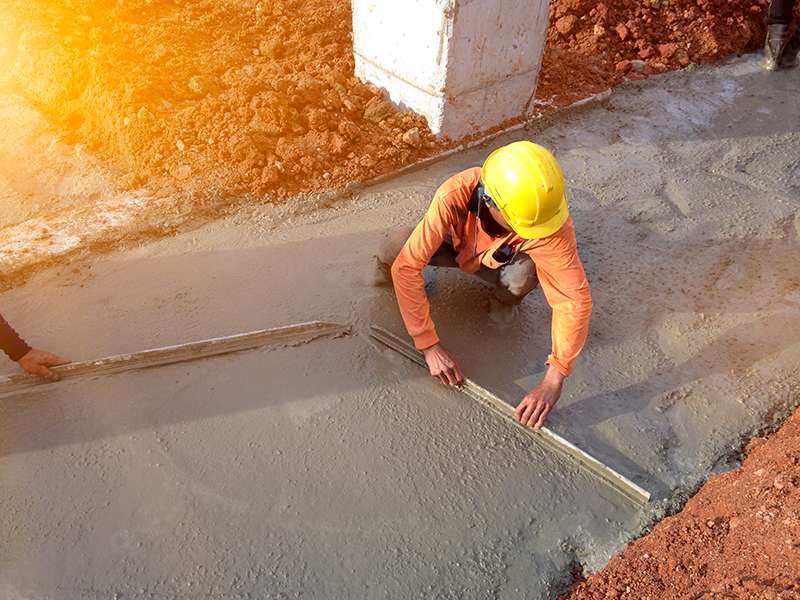
In 2010, after the scandal of the Abruzzo public buildings collapse during the earthquake, Tecnosoft immediately started to develop a method to monitor the concrete in order to make sure that they didn’t use a poor quality material in building construction and therefore compromise the buildings stability. The project was presented at the Shanghai Expo as part of Italy of Innovators initiative. The operation of the device was based on a probe which, through the dialogue via the internet with a database, compared the data with the standard parameters.
If you want to know more, read the article Il Giorno published at the time.
Today we focus on probes that monitor both humidity and temperature. Thanks to the innovative BlueLOG RH it is possible to monitor these two parameters in real time.
Let’s discover with more details why it is essential to monitor the curing of concrete.
Concrete Curing
The concrete curing (also called concrete maturation) is the phase in which the concrete gets its definitive resistance characteristics.
It is a delicate process, in which it is very important to maintain the right temperature and humidity conditions to obtain the maximum result.
Before getting into details, it is good to focus on what we are talking about.
What is concrete?
Concrete is a conglomerate made up of 3 elements:
- Inert material, such as gravel or crushed stone, which forms a large part of the concrete mass.
- Cement, with the function of binding together the various fragments of the inert material.
- Water, which activates the binding properties of the cement.
As the water naturally evaporates, the concrete gets harder becoming extremely resistant to compression and traction. That's why it is the main building material!
The 3 life stages of concrete
Concrete is produced by mixing different proportions of gravel, cement and water manually or with a concrete mixer. Once the mixture is obtained, the concrete goes through 3 stages:
1) The throw. At this stage the concrete is still liquid. Typically it is cast in the formwork, which is a base with wooden or plastic sides in which the concrete will take the shape once hardened.
2) The setting. The concrete, poured into the formwork, begins to harden changing from the liquid to the semi-liquid state. When the setting is complete (usually within a few hours), the concrete becomes solid.
3) The maturation. Immediately after setting, the solid concrete has not reached yet the optimal hardness. It is in fact still delicate and quite soft. In fact, its molecules have not sufficiently bonded with each other yet. To reach an acceptable degree of strength, it is necessary to wait for the concrete to mature. According to the regulations in force today, 28 days are considered sufficient for the concrete maturation in "standard" construction works. However, this is a very simplified view of reality: there are indeed many variables to consider.
Concrete maturation time
When it comes to concrete curing time, first of all, we must know that from a chemical point of view the process can take years.
So why is a 28-day maturity period considered fine?
This makes sense because concrete curing is not linear. In fact, the material reaches an acceptable degree of hardness in a relatively short time. From studies conducted in laboratories, it is estimated that 28 days are enough to reach 90% of the potential hardness. Over the next few years, the material continues to slowly mature and harden.
In the concrete maturation diagram, therefore, we will see a curve that rises rapidly, and then flattens as we move away from the setting date.
Accelerated concrete maturation
The cured time of 28 days is calculated for commonly used concretes. However, it is possible, through some technical measures or through the use of chemical additives, to reduce the maturation time up to 7 days and in some cases even less.
However, the resulting cement conglomerate is less resistant than the concrete cured in the 28 days “standard”.
Concrete curing time: what does it depend on?
The concrete curing depends on a variety of factors:
Water and cement ratio
Concretes with a higher water ratio than cement are more easily workable because the molecules of the cement, in solution with water, are more free to move. On the other hand, the mechanical resistance is lower.
Hydration
The more the cement is uniformly hydrated, the more the cement hardens. In fact, water helps the molecular bonds of the cement. The more its penetration is capillary, the more the concrete will tend to bond solidly with gravel and crushed stone.
On the other side, a poorly hydrated cement will tend to develop fewer molecular bonds. As a result it will be less resistant.
Environmental conditions
It is calculated that the optimal temperatures for the hardening of concrete oscillate between 18 ° C and 25 ° C.
A temperature that is too high accelerates the curing process, but reduces the hardness of the conglomerate. In fact, water needs time to "activate" the binding properties of the cement.
On the other hand, a temperature that is too low slows down the curing process. Especially, it’s important paying attention to temperatures below zero. At this temperature, the water contained in the concrete turns into ice, making the chemical bonds of the cement unstable.
Humidity also plays a very important role. Usually, a good maturity is achieved with moderate atmospheric humidity. Moisture excess slows down the natural evaporation of water from concrete, delaying its maturation.
That is why it is particularly important to monitor these parameters with construction data loggers.
Concrete maturation monitoring
Today, together with a partner company and a large international group, the cement curing certification project comes back through the use of the BlueLOG RH for temperature and humidity real-time monitoring.
 Flip through our history
Flip through our history



